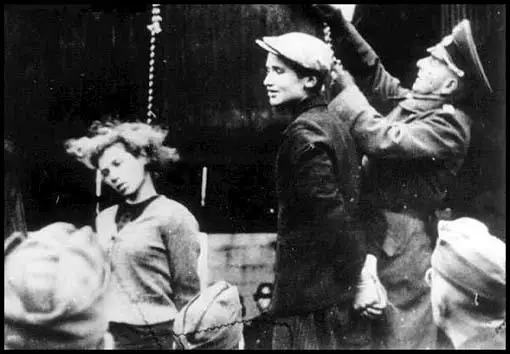Masha Bruskina
Masha Bruskina was born in Minsk, in the Soviet Union, in 1924. A member of a Jewish family, she was forced to live in the Minsk ghetto with her mother, after the arrival of the German Army in July 1941.
Although only seventeen Masha, an ardent member of the Communist Party, joined the Minsk resistance movement. She volunteered as a nurse at the hospital in the Polytechnic Institute, that had been set up to care for wounded members of the Red Army. As well as caring for the soldiers she helped them escape by smuggling into the hospital civilian clothing and false identity papers.
One of the patients informed on Masha and on 14th October she was arrested by the German authorities. She was tortured for several days but refused to give the names of other members of her group. On 20th October she wrote to her mother: "I am tormented by the thought that I have caused you great worry. Don't worry. Nothing bad has happened to me. I swear to you that you will have no further unpleasantness because of me. If you can, please send me my dress, my green blouse, and white socks. I want to be dressed decently when I leave here."
In order to frighten the people of Minsk into submission, the commander of the 707th Infantry Division, decided to hold a public hanging. On 26th October 1941, Masha Bruskina and two other members of the resistance, 16 year-old Volodia Shcherbatsevich and First World War veteran, Kiril Trus, were taken to the gates of a local yeast factory.
Antonovna Zhevzhik was a member of the assembled crowd: "Before noon, I saw the armed German and Lithuanian soldiers appear on the street. From over the bridge they escorted three people with their hands tied behind their backs. In the middle there was a girl with a signboard on her chest. They were led up to the yeast factory gate. I noticed how calmly these people walked. The girl did not look around. When they stopped one of the fascists started knocking on the door of my neighbour, asking for a chair. But she got scared and dld not open the door. In a while I saw the Germans carrying a stool from the factory weigher's booth. The factory gates were wide open. The officer threw a rope on the crossbar and made a loop. The first one led to the gallows was the girl."
Pyotr Pavlovich Borisenko was also in the crowd: "When they put her on the stool, the girl turned her face toward the fence. The executioners wanted her to stand with her face to the crowd, but she turned away and that was that. No matter how much they pushed her and tried to turn her, she remained standing with her back to the crowd. Only then did they kick away the stool from under her."

Primary Sources
(1) Masha Bruskina, letter to her mother after being imprisoned by the German authorities (20th October, 1941).
I am tormented by the thought that I have caused you great worry. Don't worry. Nothing bad has happened to me. I swear to you that you will have no further unpleasantness because of me. If you can, please send me my dress, my green blouse, and white socks. I want to be dressed decently when I leave here.
(2) Antonovna Zhevzhik witnessed the execution of Masha Bruskina on 26th October 1941.
Before noon, I saw the armed German and Lithuanian soldiers appear on the street. From over the bridge they escorted three people with their hands tied behind their backs. In the middle there was a girl with a signboard on her chest. They were led up to the yeast factory gate. I noticed how calmly these people walked. The girl did not look around. When they stopped one of the fascists started knocking on the door of my neighbour, asking for a chair. But she got scared and dld not open the door. In a while I saw the Germans carrying a stool from the factory weigher's booth. The factory gates were wide open. The officer threw a rope on the crossbar and made a loop. The first one led to the gallows was the girl.
(3) Pyotr Pavlovich Borisenko was also in the crowd when Masha Bruskina was executed.
When they put her on the stool, the girl turned her face toward the fence. The executioners wanted her to stand with her face to the crowd, but she turned away and that was that. No matter how much they pushed her and tried to turn her, she remained standing with her back to the crowd. Only then did they kick away the stool from under her.
